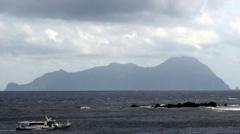For over 600 years, the people around Lake Suwa, located in the mountains of central Japan, have awaited a significant winter phenomenon that has intertwined their local culture with Shinto beliefs. This event, called the Miwatari, once represented the divine passage of gods across the frozen lake, manifesting as a prominent ridge of jagged ice after prolonged cold spells. Each winter, when the lake froze over completely, residents would find themselves awakened by ominous rumblings, heralding the arrival of this mystical ice formation believed to symbolize a visitation from the gods.
### An Iceless Winter and Ancient Omens: A Japanese Lake's Silent Warning

### An Iceless Winter and Ancient Omens: A Japanese Lake's Silent Warning
In Japan, the absence of ice from Lake Suwa during winter has residents reflecting on environmental changes and sacred traditions.
The Miwatari not only evoked wonder and reverence among the locals but also reinforced their connection to nature; its presence assured them that the world was in harmony. However, during rare winters when the Miwatari did not surface, it was seen as a dire omen indicating imbalance within the natural order.
As crucial as the Miwatari was to their cultural identity, local inhabitants meticulously documented its appearances and the climatic conditions of Lake Suwa since 1443. These records offer insights into historical weather patterns and mark significant events that corresponded with changing climates, creating an invaluable archive of centuries of frigid winters.
Recently, however, the Miwatari has become increasingly scarce, provoking concern among the community and sparking a broader conversation regarding climate change and its impact on traditional rituals. Locals are beginning to face the possibility that the absence of a once-reliable natural phenomenon may signal a future disconnected from their heritage and reverence for nature.
As these changes unfold, the icy history of Lake Suwa becomes not just a regional tale, but a poignant reminder of humanity's vulnerability in the face of an evolving planet.
As crucial as the Miwatari was to their cultural identity, local inhabitants meticulously documented its appearances and the climatic conditions of Lake Suwa since 1443. These records offer insights into historical weather patterns and mark significant events that corresponded with changing climates, creating an invaluable archive of centuries of frigid winters.
Recently, however, the Miwatari has become increasingly scarce, provoking concern among the community and sparking a broader conversation regarding climate change and its impact on traditional rituals. Locals are beginning to face the possibility that the absence of a once-reliable natural phenomenon may signal a future disconnected from their heritage and reverence for nature.
As these changes unfold, the icy history of Lake Suwa becomes not just a regional tale, but a poignant reminder of humanity's vulnerability in the face of an evolving planet.



















